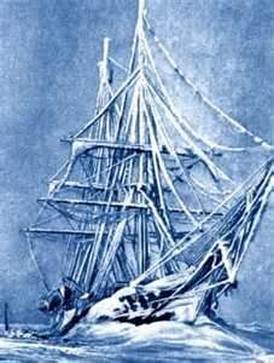The Octavius
by Andy Hagerty

In 1761, a sailing ship named The Octavius departed London bound for China. Having safely arrived at her destination about a year later. She departed China in 1762, and headed towards the Artic. That is the last her crew is heard from ever again. It was assumed She had been overtaken by the Arctic and was lost along with her crew
Although it is more legend than fact, the Octavius remains one of the most famous of all ghost ship stories. The tale of the doomed ship picks back up October 11, 1775. A whaling ship called the Herald stumbled across the Octavius floating aimlessly off the coast of Greenland. When the ship answered no hails, the crew sent a boarding party. Much to their surprise on the Octavius they discovered the bodies of the crew and passengers all frozen solid below decks frozen solid as if trying to escape the cold. The crew found the ship’s captain still sitting at his desk. He was midway through finishing a log entry from November 11, 1762, thirteen years earlier. In his cabin there was also a dead woman, a dead boy covered with a blanket and a dead sailor with a tinderbox. The boarding party took only the captain's log before leaving the vessel, because they were unwilling to search it. The ship with her crew and cargo had been adrift for almost a decade and a half.
According to the legend, it was eventually discovered in the log that the captain had gambled on making a quick return to England from the Orient via the Northwest Passage. The year had been extremely hot. However, upon reaching the Artic, somewhere above Canada, the ship had become trapped in the ice. The crew lasted some time, till the cold and dwindling provisions sealed their fate. The terrified crew of The Herald fearing of a curse and wanting nothing to do with the ship, left it abandoned touching nothing. Neither The Octavius or her ghostly crew has ever been seen again.
If this tale is true, this would mean the Octavius had completed its passage to the Atlantic as a ghost ship. The ship’s last logged position puts it at
about was 250 miles north of what is now Barrow, Alaska. The Herald found her adrift off the coast of Greenland. This would actually mean that The Octavius and her crew were the first ship to make the transit. This feat would not be accomplished by a living crew until 1903-1906 when Roald Amundsen completed the passage.
Although it is more legend than fact, the Octavius remains one of the most famous of all ghost ship stories. The tale of the doomed ship picks back up October 11, 1775. A whaling ship called the Herald stumbled across the Octavius floating aimlessly off the coast of Greenland. When the ship answered no hails, the crew sent a boarding party. Much to their surprise on the Octavius they discovered the bodies of the crew and passengers all frozen solid below decks frozen solid as if trying to escape the cold. The crew found the ship’s captain still sitting at his desk. He was midway through finishing a log entry from November 11, 1762, thirteen years earlier. In his cabin there was also a dead woman, a dead boy covered with a blanket and a dead sailor with a tinderbox. The boarding party took only the captain's log before leaving the vessel, because they were unwilling to search it. The ship with her crew and cargo had been adrift for almost a decade and a half.
According to the legend, it was eventually discovered in the log that the captain had gambled on making a quick return to England from the Orient via the Northwest Passage. The year had been extremely hot. However, upon reaching the Artic, somewhere above Canada, the ship had become trapped in the ice. The crew lasted some time, till the cold and dwindling provisions sealed their fate. The terrified crew of The Herald fearing of a curse and wanting nothing to do with the ship, left it abandoned touching nothing. Neither The Octavius or her ghostly crew has ever been seen again.
If this tale is true, this would mean the Octavius had completed its passage to the Atlantic as a ghost ship. The ship’s last logged position puts it at
about was 250 miles north of what is now Barrow, Alaska. The Herald found her adrift off the coast of Greenland. This would actually mean that The Octavius and her crew were the first ship to make the transit. This feat would not be accomplished by a living crew until 1903-1906 when Roald Amundsen completed the passage.
